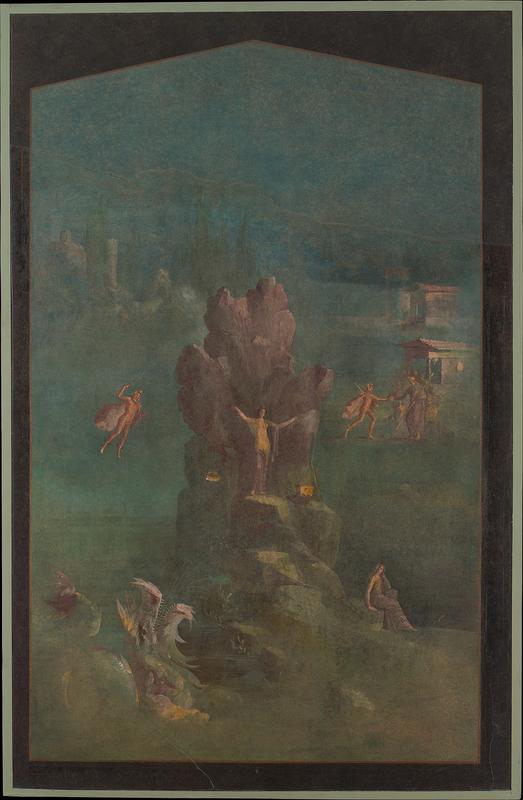More about Perseus and Andromeda in Landscape

Sr. Contributor
In this Frederic Leighton painting we have two pieces of a classic tale: Perseus about to face a sea monster to save Andromeda and, later, Perseus being thanked by her father, King Cepheus.
This composition is made by squishing two panels into a single landscape, and is called a continuous narrative. It gained popularity in Roman wall painting and this piece is the earliest known use of it. Because it was a new form deviating from popular convention, not everyone was a fan. One notable critic by the name of Vitruvius, famous for literally writing the book on architecture (called On Architecture), specifically roasted this new style in said book. He thought such frescoes served as examples of “depraved taste”.
He might not have been far off the mark if he’d been referring to the depiction of Andromeda’s bondage, which was a popular subject for erotic nudes. Specifically, it was suggestive of sadomasochistic tendencies because, hey, people of the ancient world had their kinks too. But what Vitruvius was really taking issue with was the lack of a vantage point and the whimsical treatment of the landscape.
Continuous narrative caught on regardless of his complaints, though. A painting was found in Pompeii some forty years later that basically copied this entire composition with only minor changes.
Sadly, we don’t know who it was that crafted Wall painting: Perseus and Andromeda in Landscape, but it was made with a companion fresco likely done by the same hand. The green and blue colors of the two pieces make them look near identical if you stand from a far distance. The main difference is the subject matter; sure, they have themes of love and the sea in common, but love gets interpreted quite differently in each.
The companion piece depicts the story of Polyphemus and Galatea. Since Greek mythology had several characters for both those names, I’ll be more specific. This is the famous “Nobody blinded me!” man-eating cyclops Polyphemus, and not the Argonaut who got ditched with Heracles. Also, this Galatea is one of the fifty nereides, goddesses of the sea. This “love” story is basically: cyclops spies beautiful girl, gets obsessed, but she’s not into it. She falls for someone else, so the cyclops makes a boulder fall on that guy.
Contrastingly, Perseus and Andromeda might have been one of the rare couples in Greek myth that were actually happy. Sure, their meet cute was deadly and Andromeda’s opinion of Perseus isn’t really addressed in their story...but there’s no indication of her hating him and falling for someone else. Low standard, I know, but they’re still together up in the night sky in constellation form which is far cry from the ending of the other pair.
So, on the surface the paintings made for a complimentary set, perfect for showing off in an overly lavish house if you don’t think about the stories too much.
The two pieces were housed, quite fittingly, in the Mythological Room of the villa at Boscotrecase. In ancient times, there were several villas built along the Bay of Naples, and the one at Boscotrecase was known to be the most extravagant. Hence the cutting edge art housed in an aptly named room.
As a final note, if you’re curious about how Andromeda ended up in such a near fatal predicament, it's because her mother made the not-so-wise decision of bragging about being better than an immortal. Specifically, she said she was “more beautiful than the nereids” and her daughter had to suffer for it. In this composition, you probably noticed the female figure resting on the rock in the bottom right. It’s not confirmed that it’s her mother Cassiopeia, but I like to think it’s supposed to be her reflecting on her terrible life choices.
Sources
- “The Augustan Villa at Boscotrecase.” Metmuseum.org. The Met. Accessed November 17, 2021. https://www.metmuseum.org/toah/hd/bsco/hd_bsco.htm
- Galitz, Kathryn Calley, and Thomas P. Campbell. The Metropolitan Museum of Art: Masterpiece Paintings. New York, N.Y: Skira Rizzoli Publications, Inc, 2016.
- Kleiner, Fred S. A History of Roman Art. Australia: Cengage Learning, 2018.
- Ling, Roger. Roman Painting. Cambridge: Cambridge University Press, 1998.
- Marvin, Miranda. The Language of the Muses: The Dialogue between Roman and Greek Sculpture. Los Angeles, C.A,: Getty Publications, 2008.
- “Perseus - Argive Hero & King of Greek Mythology.” Theoi. Aaron J. Atsma. Accessed November 21, 2021. https://www.theoi.com/Heros/Perseus.html.
- “Perseus 2 - Argive Hero & King of Greek Mythology.” Theoi. Aaron J. Atsma. Accessed November 21, 2021. https://www.theoi.com/Heros/Perseus2.html.
- “POLYPHEMUS (Polyphemos) - Cyclops Giant of Greek Mythology.” Theoi. Aaron J. Atsma. Accessed November 21, 2021. https://www.theoi.com/Gigante/GigantePolyphemos.html.
- “Wall Painting: Perseus and Andromeda in Landscape, from the Imperial Villa at Boscotrecase.” Metmuseum.org. The Met. Accessed November 17, 2021. https://www.metmuseum.org/ toah/hd/bsco/hd_bsco.htm.











